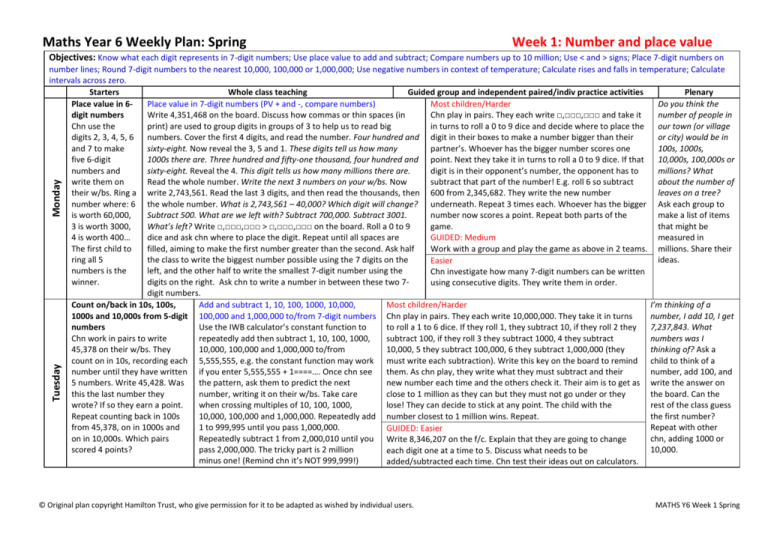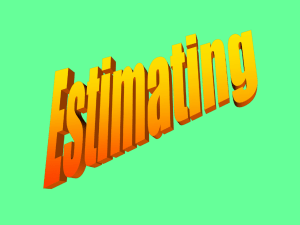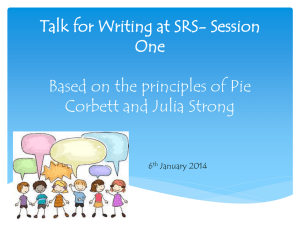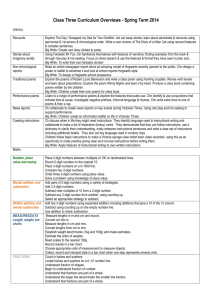Spring Week 1 Plan
advertisement

Maths Year 6 Weekly Plan: Spring Week 1: Number and place value Objectives: Know what each digit represents in 7-digit numbers; Use place value to add and subtract; Compare numbers up to 10 million; Use < and > signs; Place 7-digit numbers on Tuesday Monday number lines; Round 7-digit numbers to the nearest 10,000, 100,000 or 1,000,000; Use negative numbers in context of temperature; Calculate rises and falls in temperature; Calculate intervals across zero. Starters Whole class teaching Guided group and independent paired/indiv practice activities Plenary Place value in 6Place value in 7-digit numbers (PV + and -, compare numbers) Most children/Harder Do you think the digit numbers Write 4,351,468 on the board. Discuss how commas or thin spaces (in Chn play in pairs. They each write □,□□□,□□□ and take it number of people in Chn use the print) are used to group digits in groups of 3 to help us to read big in turns to roll a 0 to 9 dice and decide where to place the our town (or village digits 2, 3, 4, 5, 6 numbers. Cover the first 4 digits, and read the number. Four hundred and digit in their boxes to make a number bigger than their or city) would be in and 7 to make sixty-eight. Now reveal the 3, 5 and 1. These digits tell us how many partner’s. Whoever has the bigger number scores one 100s, 1000s, five 6-digit 1000s there are. Three hundred and fifty-one thousand, four hundred and point. Next they take it in turns to roll a 0 to 9 dice. If that 10,000s, 100,000s or numbers and sixty-eight. Reveal the 4. This digit tells us how many millions there are. digit is in their opponent’s number, the opponent has to millions? What write them on Read the whole number. Write the next 3 numbers on your w/bs. Now subtract that part of the number! E.g. roll 6 so subtract about the number of their w/bs. Ring a write 2,743,561. Read the last 3 digits, and then read the thousands, then 600 from 2,345,682. They write the new number leaves on a tree? number where: 6 the whole number. What is 2,743,561 – 40,000? Which digit will change? underneath. Repeat 3 times each. Whoever has the bigger Ask each group to is worth 60,000, Subtract 500. What are we left with? Subtract 700,000. Subtract 3001. number now scores a point. Repeat both parts of the make a list of items 3 is worth 3000, What’s left? Write □,□□□,□□□ > □,□□□,□□□ on the board. Roll a 0 to 9 game. that might be 4 is worth 400… dice and ask chn where to place the digit. Repeat until all spaces are GUIDED: Medium measured in The first child to filled, aiming to make the first number greater than the second. Ask half Work with a group and play the game as above in 2 teams. millions. Share their ring all 5 the class to write the biggest number possible using the 7 digits on the ideas. Easier numbers is the left, and the other half to write the smallest 7-digit number using the Chn investigate how many 7-digit numbers can be written winner. digits on the right. Ask chn to write a number in between these two 7using consecutive digits. They write them in order. digit numbers. Count on/back in 10s, 100s, Add and subtract 1, 10, 100, 1000, 10,000, Most children/Harder I’m thinking of a 1000s and 10,000s from 5-digit 100,000 and 1,000,000 to/from 7-digit numbers Chn play in pairs. They each write 10,000,000. They take it in turns number, I add 10, I get numbers Use the IWB calculator’s constant function to to roll a 1 to 6 dice. If they roll 1, they subtract 10, if they roll 2 they 7,237,843. What Chn work in pairs to write repeatedly add then subtract 1, 10, 100, 1000, subtract 100, if they roll 3 they subtract 1000, 4 they subtract numbers was I 45,378 on their w/bs. They 10,000, 100,000 and 1,000,000 to/from 10,000, 5 they subtract 100,000, 6 they subtract 1,000,000 (they thinking of? Ask a count on in 10s, recording each 5,555,555, e.g. the constant function may work must write each subtraction). Write this key on the board to remind child to think of a number until they have written if you enter 5,555,555 + 1====…. Once chn see them. As chn play, they write what they must subtract and their number, add 100, and 5 numbers. Write 45,428. Was the pattern, ask them to predict the next new number each time and the others check it. Their aim is to get as write the answer on this the last number they number, writing it on their w/bs. Take care close to 1 million as they can but they must not go under or they the board. Can the wrote? If so they earn a point. when crossing multiples of 10, 100, 1000, lose! They can decide to stick at any point. The child with the rest of the class guess Repeat counting back in 100s 10,000, 100,000 and 1,000,000. Repeatedly add number closest to 1 million wins. Repeat. the first number? from 45,378, on in 1000s and 1 to 999,995 until you pass 1,000,000. Repeat with other GUIDED: Easier on in 10,000s. Which pairs Repeatedly subtract 1 from 2,000,010 until you Write 8,346,207 on the f/c. Explain that they are going to change chn, adding 1000 or scored 4 points? pass 2,000,000. The tricky part is 2 million 10,000. each digit one at a time to 5. Discuss what needs to be minus one! (Remind chn it’s NOT 999,999!) added/subtracted each time. Chn test their ideas out on calculators. © Original plan copyright Hamilton Trust, who give permission for it to be adapted as wished by individual users. MATHS Y6 Week 1 Spring Maths Year 6 Weekly Plan: Spring Week 1: Number and place value Friday Thursday Wednesday Starters Whole class teaching Guided group and independent paired/indiv practice activities Plenary Add and subtract near multiples of Place 7-digit nos on number lines and round Most children/Easier Ask chn to write 10, 100 and 1000 to 4-digit numbers to the nearest 10,000, 100,000 or 1,000,000 Chn write at least 4 numbers on a 2,000,000 – 3,000,000 landmarked a number Write 2357 and 4178 in one set on the Ask chn to sketch a 1,000,000 to 2,000,000. line (100,000s labelled) (see resources). They write the 4 numbers between board, and 29, 51, 198, 203, 1997, They mark the number that is half way. Do underneath, and write the nearest multiple of 1,000,000 and 100,000 4,000,000 and 3005 in the second set. Explain that they agree with their neighbours? Ask chn at the side of each. 5,000,000 on chn choose a number in the first set to mark a number rounding to 1,000,000 their w/bs. Chn GUIDED: Harder and add or subtract a number from and one rounding to 2,000,000. Chn draw a Write the following numbers on the f/c: 2,345,670, 6,432,400, on each table put the second set. Challenge them to line from 2,500,000 to 2,600,000, mark on their w/bs in 9,623,000, 3,450,000, 7,600,000 and 4,000,000. Chn work in pairs to work in pairs to complete as many the halfway point, a number which rounds ascending order. write numbers which round to 2,345,670 when rounded to the additions and subtractions as they can to 2,500,000 and one which rounds to nearest 10. One child writes a number which rounds down, the other in 7 minutes. There are 20 possible 2,600,000. Repeat for numbers between a number which rounds up. Repeat for the other numbers, rounding combinations! 2,530,000 and 2,540,000. to the nearest 100, 1000, 10,000, 100,000 and finally 1,000,000 Place negative and positive Use negative numbers in context of temperature; Calculate rises and falls Most children As a class numbers on lines in temperature Chn order temperatures and calculate rises and sketch a bar Play the number line game at Launch the ITP Thermometer, and choose a range of -10 to 10. At what falls in temperature (see resources). graph to show http://mathsframe.co.uk/en/ sort of temperature might we get ice outside? Why? Agree that as water GUIDED: Easier the resources/resource/37/placin freezes at 0 degrees Celsius the temperature will be less than this, e.g. Support children in sketching vertical number lines temperature g_numbers_on_a_number_li minus one, -2, etc. Ask chn to label some temperatures on thermometer. to answer the questions. for each day, ne, choosing -50 to 50 and Which of these temperatures is the coldest? During one day it was 7 °C. At Harder drawing bars landmarks on the line. Have a night the temperature fell to minus 3 °C. Move the slide to 7, then –3 on beneath the Chn use www.bbc.co.uk/weather to find the fivechild from each group ready the thermometer. How many degrees has the temperature fallen? How horizontal axis day forecast for New York. They work out the to drag the flag on the line as many degrees had it fallen when it got to zero? Draw a hop of 7 to 0. And to show the range of temperature for each day. They find time is crucial! Points earn then? Draw a hop of 3 to –3. Click on ‘change’ to check. Move the slider negative another city where the daytime temperatures are extra time. Chn could play in up to 3°C. The next day the temperature rose, but it was colder than the temperatures. above freezing and night time temperatures are pairs on laptops or mobile previous day. How much has the temperature gone up by? Draw a hop of below and see if they can find a greater range devices. 3 to 0°C, and then a hop of 3 to 3°C. Repeat with similar questions. between day and night time temperatures. Read Roman numerals Calculate intervals across zero Whole class investigation What did children find Play the crocodile board game at Show a line from –20 to 20, with 0 and multiples of 5 labelled Ask chn to work out –5 + 7 and –5 – 7. They then out? What did they http://mathgames4children.com (see resources). This number line has both positive and negative add the large answer (2) to the smaller answer (– think would happen if /fun-board-games/5thnumbers. We can have numbers less than 0! For example, if the 12) to give –10. Ask them to work in pairs to add we always started grade/crocs/roman-numeralstemperature is less than 0 or a bank account is overdrawn, or we and subtract numbers to/from –5 to give one with -4? Try and few crocodile-grade-5-game.html. are below ground. Point to –20. We can read this as negative 20. answer >0 and one answer <0. They add the pairs examples, e.g. –4 + 6 All chn write A, B, C or D on their What do you think will be the next number? And the next? Count of answers. What do they find? (The sum is = 2, –4 – 6 = –10. 2 – w/bs to answer. Enter the most on from –20 through 0 to 20. If we have 5 subtract 6, we’d always –10.) 10 = –8. What do you common answer. Alternatively normally say we can’t do it, but we can if we use negative nos. Easier: Chn use a –20 to 20 number line to help. think would happen if chn play in pairs on What do you think 5 subtract 6 is? Challenge chn to work in pairs GUIDED: Sit with different groups to assess their we started with -3? laptops/mobile devices. to make up some other subtractions with a negative answer. understanding. Scroll down for resources, Abacus Textbook pages and Outcomes © Original plan copyright Hamilton Trust, who give permission for it to be adapted as wished by individual users. MATHS Y6 Week 1 Spring Maths Year 6 Weekly Plan: Spring Week 1: Number and place value Resources 0 to 9 dice Calculators 1 to 6 dice Wednesday: Activity sheet of 2,000,000 – 3,000,000 landmarked line (100,000s labelled) (see resources) Number line game at http://mathsframe.co.uk/en/resources/resource/37/placing_numbers_on_a_number_line ITP Thermometer (see resources) Thursday: Temperature Activity sheet (see resources) Website: www.bbc.co.uk/weather Crocodile board game at http://mathgames4children.com/fun-board-games/5th-grade/crocs/roman-numerals-crocodile-grade-5-game.html Friday: -20 to 20 line (see resources) Abacus Year 6 Textbooks 1 and 2 Abacus Textbook Pages for Alternative/Additional Practice Day Monday Wednesday Thursday Group Easier Most children Harder Most children Page Textbook 2, pages 4 and 9 Textbook 2, pages 5 and 7 Textbook 2, pages 6 and 8 Textbook 2, page 10 Most children Harder Textbook 1, page 61 Textbook 1, page 60 The links to the websites and the contents of the web pages associated with such links specified on this list (hereafter collectively referred to as the ‘Links’) have been checked by Hamilton Trust (being the operating name of the registered charity, William Rowan Hamilton Trust) and to the best of Hamilton Trust’s knowledge, are correct and accurate at the time of publication. Notwithstanding the foregoing or any other terms and conditions on the Hamilton Trust website, you acknowledge that Hamilton Trust has no control over such Links and indeed, the owners of such Links may have removed such Links, changed such Links and/or contents associated with such Links. Therefore, it is your sole responsibility to verify any of the Links which you wish you use. Hamilton Trust excludes all responsibility and liability for any loss or damage arising from the use of any Links. Scroll down for Outcomes © Original plan copyright Hamilton Trust, who give permission for it to be adapted as wished by individual users. MATHS Y6 Week 1 Spring Maths Year 6 Weekly Plan: Spring Week 1: Number and place value Outcomes Monday Tuesday 1. Say what each digit represents in a 7-digit number. 2. Write place value related additions and subtractions. 3. Compare pairs of 7-digit numbers. 1. Add and subtract 1, 10, 100, 1000, 10,000, 100,000 and 1,000,000 to/from 7-digit numbers. Outcomes for most children Wednesday 1. Place 7-digit numbers on empty number lines. 2. Round 7-digit numbers to the nearest 10, 100, 1000, 10,000, 100,000 or 1,000,000. Thursday 1. Use negative numbers in context of temperature. 2. Calculate rises and falls in temperature. Friday 1. Calculate intervals across zero. Default (outcomes for children not on statements but not able to reach the outcomes for most children) 1. Say what each digit represents in a 7-digit number. 2. Order 7-digit numbers. 1. Know what each digit represents in a 7-digit number. 2. Write place value related additions and subtractions. 1. Place 7-digit numbers on landmarked lines. 2. Round 7-digit numbers to the nearest 100,000 or 1,000,000. 1. Use negative numbers in context of temperature. 2. Calculate rises and falls in temperature. 1. Calculate intervals across zero using a number line to help. Only record names of children who struggled or exceeded these outcomes © Original plan copyright Hamilton Trust, who give permission for it to be adapted as wished by individual users. MATHS Y6 Week 1 Spring







